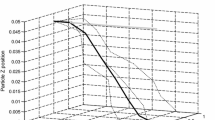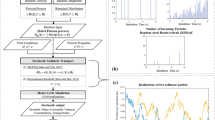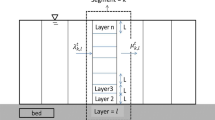Abstract
A sediment particle in a flow not only follows the flow direction but also randomly diffuses through the surrounding fluid, because of the turbulence in the flow. In this study, particle movement is regarded as a stochastic process. The stochastic-diffusion particle tracking model is able to simulate the random characteristics of particle trajectories based on stochastic methodologies and physical mechanisms. This study proposes a state-of-the-art two-particle stochastic-diffusion particle tracking model, which considers particle correlation. The spatial correlation depends on the distance between paired particles. Particles are highly correlated and have similar random movement because of large-scale eddies when paired particles are located in the immediate vicinity of each other. The model is applied to open-channel flows, and simulation results of ensemble means and variances of particle positions are examined. Concentration results can be expressed as time-varying probability density functions. The proposed models are validated against the experimental data through ensemble mean velocities and sediment concentrations. This study also examines whether movements of sediment particles in open-channel flow follow the Fickian law. Simulation results of ensemble variances of particle displacements in longitudinal and vertical directions reveal a deviation from the Fickian hypothesis. The influence of the resuspension mechanism on the observed anomalous diffusions is discussed.












Similar content being viewed by others
Abbreviations
- \(\varvec{A}\left( {\varvec{X}_{t} ,t} \right)\) :
-
The drift terms in the SDE
- B t :
-
The standard Brownian motion modeled by the Wiener process
- \(\varvec{B}_{t}^{\prime }\) :
-
A correlated Brownian motion independent of B
- C μ :
-
Empirical coefficients given as 0.09 (Toorman 2008)
- DX :
-
A constant related to the numerical grid size in f(r)
- d :
-
Sediment particle diameter
- E[·]:
-
Expected value
- f(r):
-
A correlated coefficient related to the distance between paired particles r
- g :
-
Gravity acceleration
- H :
-
Water depth
- I :
-
Identity matrix
- k :
-
The turbulent kinetic energy
- k′:
-
The coefficient of experimental investigation, Cai (1965) gives a value 0.75 for k by considering the force conservation
- k s :
-
The roughnees high
- l :
-
The Prandtl’s mixing length
- \({\mathcal{N}}\left( {0,1} \right)\) :
-
The standard normal distribution with a zero mean and a unit standard deviation
- r :
-
The distance between paired particles \(r = \left\| {\varvec{X}^{\left( i \right)} - \varvec{X}^{\left( j \right)} } \right\|\)
- \(\text{Re}_{{{\text{k}}_{\text{s}} }}\) :
-
The roughness Reynolds number, \(\text{Re}_{{k_{s} }} = k_{s} u_{*} /\nu\)
- Reτ :
-
The friction Reynolds number
- Sc t :
-
The Schmidt number
- St :
-
The Stokes number
- S v :
-
The sediment volume concentration
- \(\bar{U},\bar{V},\bar{W}\) :
-
The mean flow velocities of direction x, y and z, respectively
- u * :
-
Shear velocity
- \(\bar{u}\) :
-
Mean velocity in x direction
- u’, v’ :
-
Velocity fluctuations caused by turbulent eddies in longitudinal and vertical directions
- \(\sqrt {\overline{{w^{{{\prime }2}} }} }\) :
-
Turbulent intensity
- w′:
-
Velocity fluctuations in vertical direction
- w s :
-
The settling velocity of sediment particle at concentration Sv
- \(w_{{s_{0} }}\) :
-
The settling velocity of sediment particle at zero concentration
- \(\hat{w}\) :
-
\(w^{\prime } /\upsigma_{2}\)
- \(\left\langle x \right\rangle\) :
-
The mean of the particle displacement xi over time t
- X t :
-
\(\varvec{X}_{t} = \left\{ {X\left( t \right),Z\left( t \right)} \right\}\) particle position at time t
- α 0 :
-
A coefficient for two-equation (k–ε model) which is defined as α/Cμ
- β :
-
The constant diffusion effect which can be chosen between 0 and 1
- \(\beta \varvec{B}_{t}^{{\prime }}\) :
-
The diffusion due to large scale turbulence
- \(\sqrt {1 - \beta^{2} } \Delta B_{t}\) :
-
The diffusion due to molecular diffusion and small scale turbulence
- γx, γz :
-
The scaling diffusion exponent in x and z directions
- ε :
-
Diffusion coefficient
- ε m :
-
The momentum exchange coefficient
- ε s :
-
The turbulent diffusion coefficients of suspended particles
- εx, εy, εz :
-
The sediment diffusion coefficient in x, y and z direction
- κ :
-
The von Karman constant
- ν :
-
The kinematic viscosity
- ν t :
-
The eddy viscosity or the diffusivity of momentum
- ρf, ρs :
-
The density of fluid and solid, respectively
- \(\varvec{\sigma}\left( {\varvec{X}_{t} ,t} \right)\) :
-
The diffusion terms in the SDE
- σ 2 :
-
The root-mean square of w′
- σx, σz :
-
The ensemble averaging mean-square particle displacement in x and z directions
- τ p :
-
The particle timescale
- τ t :
-
The turbulent shear stress
- τ w :
-
The wall shear stress
References
Absi R (2005) Comment on “Turbulent diffusion of momentum and suspended particles: A finite-mixing-length theory” [Phys. Fluids 16, 2342 (2004)]. Phys Fluids 17:2342
Absi R (2019) Eddy viscosity and velocity profiles in fully-developed turbulent channel flows. Fluid Dyn 54:137–147. https://doi.org/10.1134/s0015462819010014
Absi R, Marchandon S, Lavarde M (2011) Turbulent diffusion of suspended particles: analysis of the turbulent Schmidt number. In: Öchsner A, Murch GE, João MPQ (eds) DelgadoDefect and diffusion forum. Trans Tech Publ, pp 794–799. https://doi.org/10.4028/www.scientific.net/DDF.312-315.794
Afonso MM (2014) Anomalous diffusion for inertial particles under gravity in parallel flows. Physical Review E 89:063021
Bolin D (2009) Computationally efficient methods in spatial statistics. Doctoral dissertation, Ph. D. thesis, Lund University, Centre for Mathematical Sciences
Borgas M, Sawford B (1991) The small-scale structure of acceleration correlations and its role in the statistical theory of turbulent dispersion. J Fluid Mech 228:295–320
Borgas M, Sawford B (1994) A family of stochastic models for two-particle dispersion in isotropic homogeneous stationary turbulence. Journal of fluid mechanics 279:69–99
Bose SK, Dey S (2010) Universal probability distributions of turbulence in open channel flows. J Hydraul Res 48:388–394
Bose SK, Dey S (2013) Sediment entrainment probability and threshold of sediment suspension: exponential-based approach. Journal of Hydraulic Engineering 139:1099–1106
Bradley DN, Tucker GE, Benson DA (2010) Fractional dispersion in a sand bed river. J Geophys Res Earth Surf. https://doi.org/10.1029/2009JF001268
Cai ST (1965) Settling of sediment particles in quiescent water—(1) the effect of concentration on fall velocity. Journal of Physics 12:402–408 (in Chinese)
Castiglione P, Mazzino A, Muratore-Ginanneschi P, Vulpiani A (1999) On strong anomalous diffusion. Physica D 134:75–93
Cellino M (1998) Experimental study of suspension flow in open channels. Politecnico di Torino, Turin
Chen D, Sun H, Zhang Y (2013) Fractional dispersion equation for sediment suspension. Journal of hydrology 491:13–22
Chen Y-F, Wei H-H, Sheng Y-J, Tsao H-K (2016) Superdiffusion in dispersions of active colloids driven by an external field and their sedimentation equilibrium. Physical Review E 93:042611
Cheng N-S, Chiew Y-M (1998a) Pickup probability for sediment entrainment. Journal of Hydraulic Engineering 124:232–235
Cheng N-S, Chiew Y-M (1998b) Modified logarithmic law for velocity distribution subjected to upward seepage. J Hydraul Eng 124:1235–1241
Cheng N-S, Chiew Y-M (1999) Analysis of initiation of sediment suspension from bed load. J Hydraul Eng 125:855–861
Chien N, Wan Z (1999) Mechanics of sediment transport. ASCE Press, Virginia, USA. https://doi.org/10.1061/9780784404003
Coleman NL (1970) Flume studies of the sediment transfer coefficient. Water Resour Res 6:801–809
Coleman NL (1986) Effects of suspended sediment on the open-channel velocity distribution. Water Resour Res 22:1377–1384
Cressie N (1992) Statistics for spatial data. Terra Nova 4:613–617
Dey S, Swargiary D, Sarkar S, Fang H, Gaudio R (2018) Turbulence features in a wall-wake flow downstream of a wall-mounted vertical cylinder. European Journal of Mechanics-B/Fluids 69:46–61
Dimou KN, Adams EE (1993) A random-walk, particle tracking model for well-mixed estuaries and coastal waters. Estuarine Coastal Shelf Science 37:99–110
Durbin P (1980) A stochastic model of two-particle dispersion and concentration fluctuations in homogeneous turbulence. J Fluid Mech 100:279–302
Einstein HA (1950) The bed-load function for sediment transportation in open channel flows, vol 1026. United States Department of Agriculture, U.S. Government Printing Office, Washington, DC
Escande DF, Sattin F (2007) When can the Fokker–Planck equation describe anomalous or chaotic transport? Phys Rev Lett 99:185005
Fan N, Singh A, Guala M, Foufoula-Georgiou E, Wu B (2016) Exploring a semimechanistic episodic Langevin model for bed load transport: emergence of normal and anomalous advection and diffusion regimes. Water Resour Res 52:2789–2801
Fischer H, List E, Koh R, Imberger J, Brooks N (1979) Mixing in inland and coastal waters. Academic Press, New York, pp 229–242
Gardiner CW (1985) Stochastic methods. Springer, Berlin
Havlin S, Bunde A, Stanley HE (1986) Anomalous ballistic diffusion. Physical Review B 34:445–447
Heemink A (1990) Stochastic modelling of dispersion in shallow water. Stochastic Hydrology and hydraulics 4:161–174
Kumar N, Harbola U, Lindenberg K (2010) Memory-induced anomalous dynamics: emergence of diffusion, subdiffusion, and superdiffusion from a single random walk model. Phys Rev E 82:021101
Man C (2007) Stochastic modeling of suspended sediment transport in regular and extreme flow environments. ProQuest
Mandelbrot BB, Van Ness JW (1968) Fractional Brownian motions, fractional noises and applications. SIAM review 10:422–437
Martin RL, Jerolmack DJ, Schumer R (2012) The physical basis for anomalous diffusion in bed load transport. J Geophys Res Earth Surf. https://doi.org/10.1029/2011JF002075
Mei CC, Chian C (1994) Dispersion of small suspended particles in a wave boundary layer. Journal of physical oceanography 24:2479–2495
Muste M, Yu K, Fujita I, Ettema R (2009) Two-phase flow insights into open-channel flows with suspended particles of different densities. Environmental fluid mechanics 9:161–186
Nie S, Sun H, Zhang Y, Chen D, Chen W, Chen L, Schaefer S (2017) Vertical distribution of suspended sediment under steady flow: existing theories and fractional derivative model. Discrete Dyn Nat Soc 2017:5481531. https://doi.org/10.1155/2017/5481531
Nikora V, Habersack H, Huber T, McEwan I (2002) On bed particle diffusion in gravel bed flows under weak bed load transport. Water Resour Res 38
Oh J, Tsai CW (2010) A stochastic jump diffusion particle‐tracking model (SJD-PTM) for sediment transport in open channel flows. Water Resour Res 46:W10508. https://doi.org/10.1029/2009WR008443
Park I, Seo IW (2018) Modeling non-Fickian pollutant mixing in open channel flows using two-dimensional particle dispersion model. Advances in water resources 111:105–120
Pusey PN (2011) Brownian motion goes ballistic. Science 332:802–803
Reynolds A (1998) A Lagrangian stochastic model for the trajectories of particle pairs and its application to the prediction of concentration variance within plant canopies. Boundary-Layer Meteorology 88:467–478
Risken H (1989) The Fokker–Planck equation. Methods of solution and applications, vol 18 of Springer series in synergetics
Saletti M, Molnar P, Zimmermann A, Hassan MA, Church M (2015) Temporal variability and memory in sediment transport in an experimental step-pool channel. Water Resour Res 51:9325–9337
Schumer R, Meerschaert MM, Baeumer B (2009) Fractional advection‐dispersion equations for modeling transport at the Earth surface. J Geophys Res Earth Surf 114:F00A07. https://doi.org/10.1029/2008JF001246
Sharma SN, Patel HG (2010) The Fokker–Planck equation. INTECH Open Access Publisher
Socolofsky SA, Jirka GH (2005) Special topics in mixing and transport processes in the environment, engineering lectures, 5th edn. Texas A&M University, College Station
Spivakovskaya D, Heemink A, Schoenmakers J (2007) Two-particle models for the estimation of the mean and standard deviation of concentrations in coastal waters. Stoch Env Res Risk Assess 21:235
Spurk J, Aksel N (2008) Fluid mechanics. Springer, Berlin
Sun H, Li Z, Zhang Y, Chen WJC (2017) Fractional and fractal derivative models for transient anomalous diffusion: model comparison. Solitons Fract 102:346–353
Thomson D (1990) A stochastic model for the motion of particle pairs in isotropic high-Reynolds-number turbulence, and its application to the problem of concentration variance. J Fluid Mech 210:113–153
Toorman EA (2008) Vertical mixing in the fully developed turbulent layer of sediment-laden open-channel flow. Journal of hydraulic engineering 134:1225–1235
Tsai CW, Man C, Oh J (2014) Stochastic particle based models for suspended particle movement in surface flows. Int J Sedim Res 29:195–207. https://doi.org/10.1016/S1001-6279(14)60036-6
Tsai CW, Hung SY, Oh J (2018) A stochastic framework for modeling random-sized batch arrivals of sediment particles into open channel flows. Stoch Env Res Risk Assess 32:1939–1954. https://doi.org/10.1007/s00477-018-1529-x
Vlahos L, Isliker H, Kominis Y, Hizanidis K (2008) Normal and anomalous diffusion: a tutorial. arXiv preprint arXiv:08050419
Wilson JD, Sawford BL (1996) Review of Lagrangian stochastic models for trajectories in the turbulent atmosphere. Boundary-layer meteorology 78:191–210
Wu F-C, Chou Y-J (2003a) Rolling and lifting probabilities for sediment entrainment. Journal of Hydraulic Engineering 129:110–119
Wu F-C, Chou Y-J (2003b) Rolling and lifting probabilities for sediment entrainment. J Hydraul Eng 129:110–119
Wu F-C, Lin Y-C (2002a) Pickup probability of sediment under log-normal velocity distribution. Journal of Hydraulic Engineering 128:438–442
Wu F-C, Lin Y-C (2002b) Pickup probability of sediment under log-normal velocity distribution. J Hydraul Eng 128:438–442
Yen BC (2002) Stochastic inference to sediment and fluvial hydraulics. Journal of Hydraulic Engineering 128:365–367
Yu X, Zhang Y, Sun H, Zheng CJC (2018) Time fractional derivative model with Mittag–Leffler function kernel for describing anomalous diffusion: analytical solution in bounded-domain and model comparison. Solitons Fract 115:306–312
Acknowledgements
This research was supported by the Taiwan Ministry of Science and Technology under Grant Contract Number 107-2628-E-002-002-MY3, and 108-2221-E-002-011-MY3. The research fund awarded to the first author by the US National Science Foundation under Grant Contract Number EAR-0748787 is appreciated. The authors state that data used are available in the tables and figures in the manuscript.
Author information
Authors and Affiliations
Corresponding author
Additional information
Publisher's Note
Springer Nature remains neutral with regard to jurisdictional claims in published maps and institutional affiliations.
Rights and permissions
About this article
Cite this article
Tsai, C.W., Hung, S.Y. & Wu, TH. Stochastic sediment transport: anomalous diffusions and random movement. Stoch Environ Res Risk Assess 34, 397–413 (2020). https://doi.org/10.1007/s00477-020-01775-3
Published:
Issue Date:
DOI: https://doi.org/10.1007/s00477-020-01775-3




